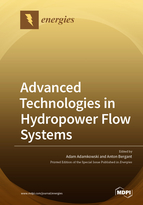Advanced Technologies in Hydropower Flow Systems
A special issue of Energies (ISSN 1996-1073). This special issue belongs to the section "A3: Wind, Wave and Tidal Energy".
Deadline for manuscript submissions: closed (31 March 2022) | Viewed by 17156
Special Issue Editors
Interests: hydropower; hydraulic machinery; water hammer; fluid mechanics; renewable energy; hydraulics; data acquisition; fluid flow; piping; boundary layer; optical engineering; power plants; liquids; pressure measurement; pipeline; curve fitting; instrument handling; cavitation; unsteady flows
Special Issues, Collections and Topics in MDPI journals
2. Faculty of Mechanical Engineering, University of Ljubljana, Ljubljana, Slovenia
Interests: mechanical engineering; hydropower; piping; modeling and simulation; fluid mechanics numerical modeling; fluid transients; cavitation; friction; fluid structure interaction
Special Issue Information
Dear Colleagues,
Despite many years of development in the hydropower sector, the global energy potential of water resources is still not sufficiently used. This particularly concerns low- and ultra-low-head facilities, which are mostly common. The search for modern, high-performance technologies in the field of hydraulic machines and their flow systems is one of the most important issues that can contribute to greater profitability and thus, the further development of low-head and hydrokinetic machine technologies.
I hope that the proposed Special Issue will enable the dissemination of contemporary scientific and technical achievements, and a broad discussion on the possibilities of their use for the development of hydropower. Special attention will be paid to innovative solutions used in hydraulic machines and their flow systems, as well as to methods of operation and maintenance aided by up-to-date tools, taking into account the criteria for the optimal operation of hydropower plants. Research papers on steady and unsteady flow analysis which aim to improve the performance characteristics and/or operation safety of hydraulic structures and equipment, as well as elongate their lifetime, are also most welcome. In addition, the contribution of research papers which aim to increase the flexibility of the hydropower installations and deal with such problems as hydraulic transients, off-design operation or cavitation phenomena will be highly valued.
I believe that the papers collected and selected in this way will enable the acceleration of the sustainable development of hydropower and its wider use, and, as a consequence, will contribute to ensuring energy security and the protection of water resources.
Prof. Dr. Adam Adamkowski
Dr. Anton Bergant
Guest Editors
Manuscript Submission Information
Manuscripts should be submitted online at www.mdpi.com by registering and logging in to this website. Once you are registered, click here to go to the submission form. Manuscripts can be submitted until the deadline. All submissions that pass pre-check are peer-reviewed. Accepted papers will be published continuously in the journal (as soon as accepted) and will be listed together on the special issue website. Research articles, review articles as well as short communications are invited. For planned papers, a title and short abstract (about 100 words) can be sent to the Editorial Office for announcement on this website.
Submitted manuscripts should not have been published previously, nor be under consideration for publication elsewhere (except conference proceedings papers). All manuscripts are thoroughly refereed through a single-blind peer-review process. A guide for authors and other relevant information for submission of manuscripts is available on the Instructions for Authors page. Energies is an international peer-reviewed open access semimonthly journal published by MDPI.
Please visit the Instructions for Authors page before submitting a manuscript. The Article Processing Charge (APC) for publication in this open access journal is 2600 CHF (Swiss Francs). Submitted papers should be well formatted and use good English. Authors may use MDPI's English editing service prior to publication or during author revisions.
Keywords
- hydraulic machinery
- hydrokinetic turbines
- pumps as turbines (PAT)
- piping
- flow measurements
- efficiency measurements
- optimal operation
- hydraulic diagnostics
- hydraulic transients
- cavitation







